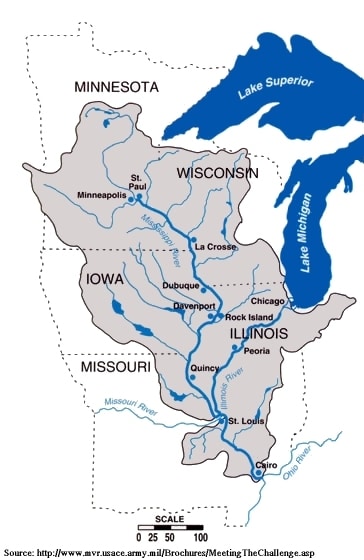Rivers Protect Us
 Nature has ways of protecting people, property, and wildlife. Let nature protect all of us. The importance of floodplains and wetlands cannot be overstated. Floodplains are the low-lying areas adjacent to rivers that are formed by sediment deposited by rivers. The floodplain is an integral part of a river and is essential for a healthy functioning river system. A wetland is a land area that is covered with water, either permanently or seasonally. They include aquatic plants specifically adapted to the hydric, or very wet, soils found there. Floodplains and wetlands provide a myriad of benefits including habitat for fish and other wildlife, pollution filtration, flood protection, groundwater recharge, and rich, fertile soils for farming.
Nature has ways of protecting people, property, and wildlife. Let nature protect all of us. The importance of floodplains and wetlands cannot be overstated. Floodplains are the low-lying areas adjacent to rivers that are formed by sediment deposited by rivers. The floodplain is an integral part of a river and is essential for a healthy functioning river system. A wetland is a land area that is covered with water, either permanently or seasonally. They include aquatic plants specifically adapted to the hydric, or very wet, soils found there. Floodplains and wetlands provide a myriad of benefits including habitat for fish and other wildlife, pollution filtration, flood protection, groundwater recharge, and rich, fertile soils for farming.
Problem: Disconnected Rivers & Levees
 Despite the many benefits of floodplains, rivers across the United States have been disconnected from their floodplains on a grand scale, largely through river channelization and levees. Once a river becomes disconnected from its floodplain, the benefits they provide are lost. Levees also make floods worse because they force flood waters into a narrower river channel, making the water flow higher, faster, and with greater force, which can cause more powerful floods both up and downstream. For too long, wetlands have been viewed as wastelands to be filled in and built upon. As a result, extensive losses have occurred. Illinois has lost 85% of its wetlands.
Despite the many benefits of floodplains, rivers across the United States have been disconnected from their floodplains on a grand scale, largely through river channelization and levees. Once a river becomes disconnected from its floodplain, the benefits they provide are lost. Levees also make floods worse because they force flood waters into a narrower river channel, making the water flow higher, faster, and with greater force, which can cause more powerful floods both up and downstream. For too long, wetlands have been viewed as wastelands to be filled in and built upon. As a result, extensive losses have occurred. Illinois has lost 85% of its wetlands.
Solution: Reconnecting Floodplains and Restoring Wetlands
Prairie Rivers Network supports levee setbacks or removals as an effective method of reconnecting rivers and their natural floodplains. Setting a levee further back from a river can allow for greater floodplain connection while still protecting buildings or crops behind the relocated levee. We share the stories of the effects on communities when levees along the Mississippi River are misused in our podcast Stories from the Floodplain. We work with partners to restore wetlands along the Illinois River, as wetlands are considered the most biologically diverse of all ecosystems. As such they provide habitat for thousands of plant and animal species. Migrating birds use wetlands for feeding, resting, and nesting. Fish, amphibians, and other aquatic species depend on healthy floodplains as well. Reconnecting rivers with their floodplains can restore vital ecological functions that have been lost over a century of degradation. Key actions that we are working on include:
- Reform laws and policies governing levee districts and drainage districts to support floodplain reconnection and headwater stream restoration
- Educate the public and decision-makers about the benefits of natural river, wetland, and floodplain functions
- Advocate for the funding of restoration programs that establish healthy aquatic and riparian habitats along rivers and streams
- Assess social vulnerability related to flood risk management policy





 Illinois has...
Illinois has...





